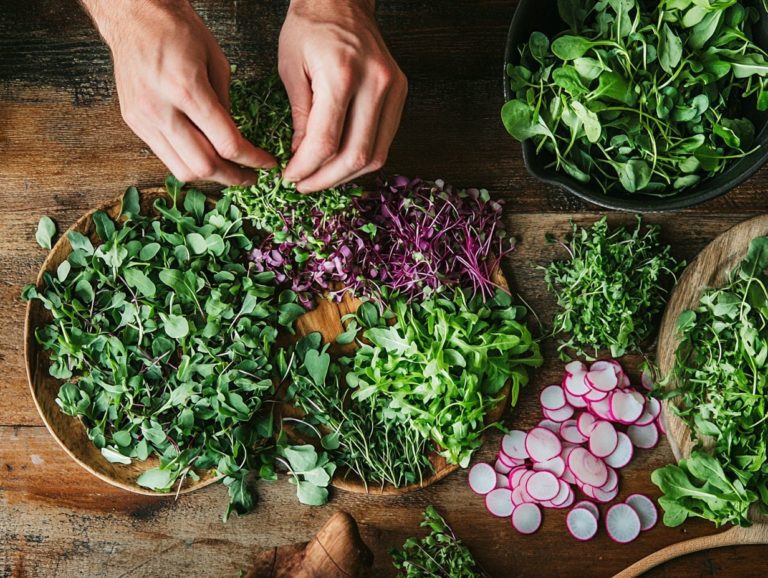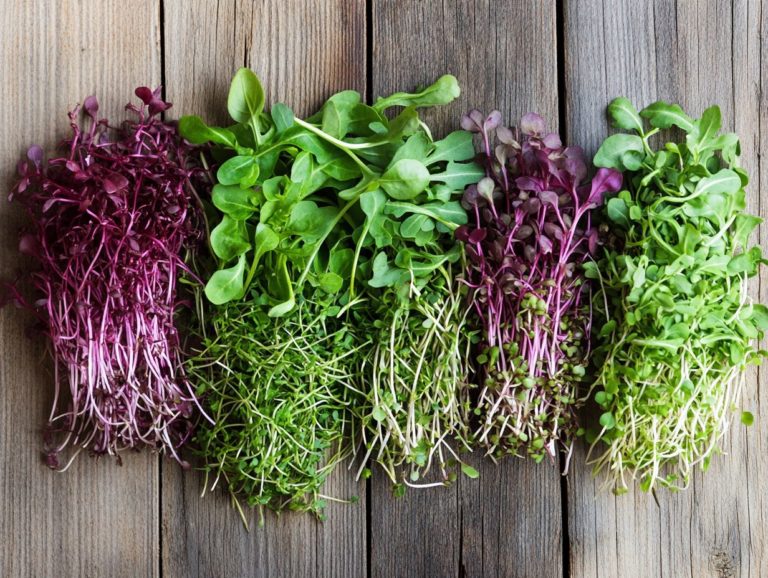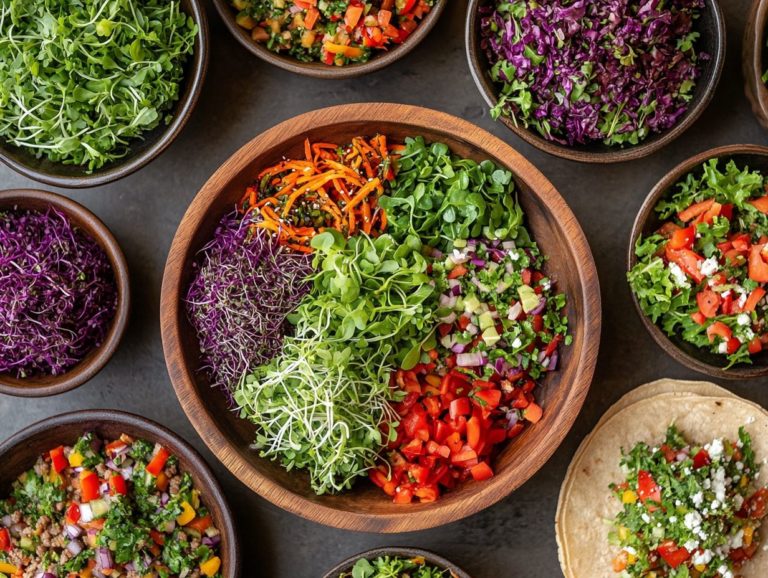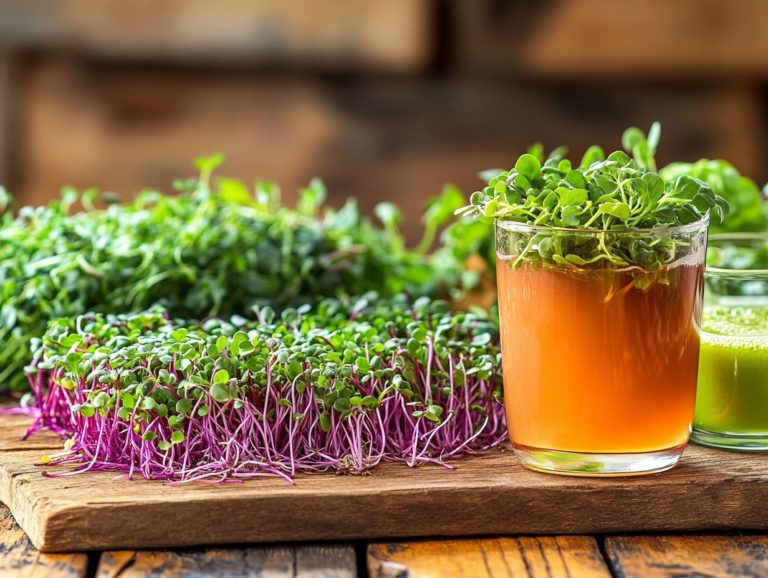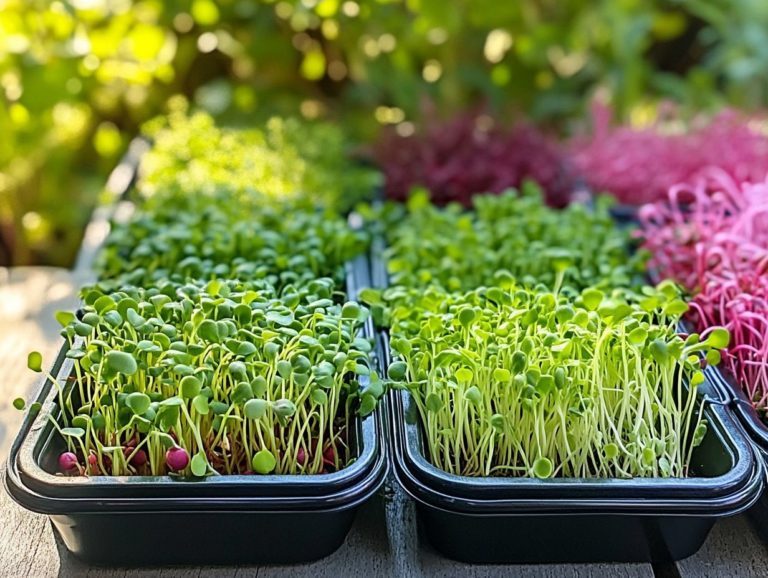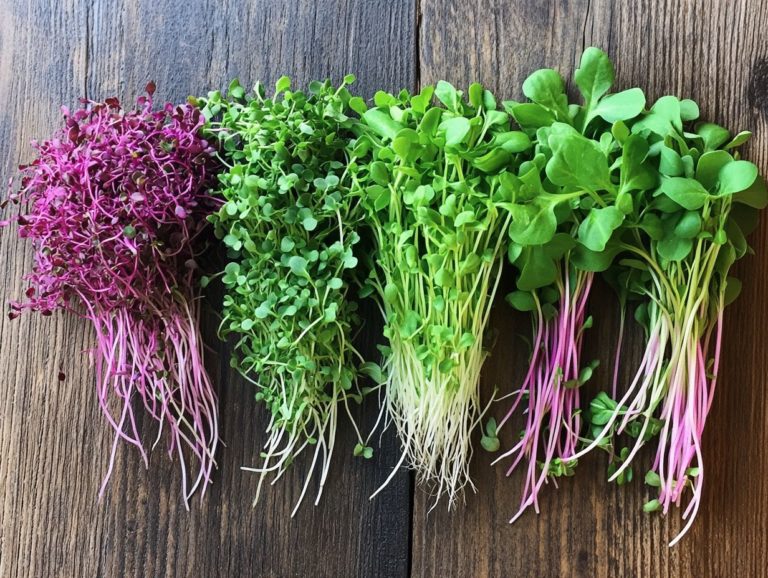Enjoying the Flavor Profiles of Microgreen Varieties
Microgreens aren t merely trendy garnishes; they bring a delightful burst of flavor and a remarkable nutritional boost to your meals.
This article delves into the essence of microgreens and the many benefits they can offer to your diet. With their diverse nutritional profiles and an exciting array of flavors, you’ll discover just how simple it is to cultivate your own at home.
You will explore new ways to incorporate these tiny greens into your dishes, turning everyday meals into delicious meals. Get ready to transform your cooking and boost your health with microgreens!
Contents
Key Takeaways:
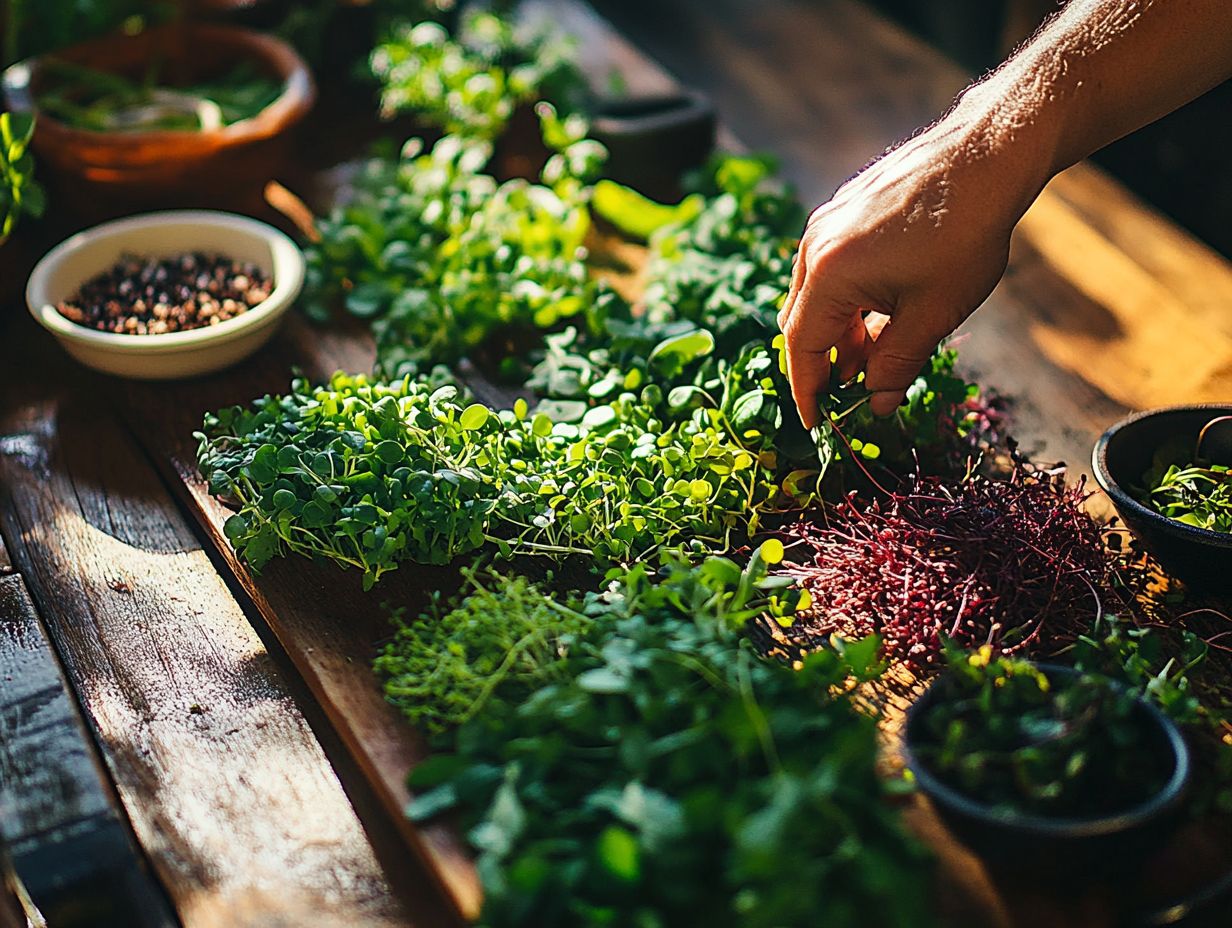
- Discover the health benefits of microgreens and how they can enhance your diet.
- Experiment with different flavor profiles of microgreens to elevate your meals.
- Learn how to grow your own microgreens at home and incorporate them into your cooking in creative ways.
What are Microgreens?
Microgreens are those young, edible plants you harvest just after the first leaves make their appearance, typically within 7 to 21 days post-germination. Their vibrant colors, distinctive flavors, and impressive nutritional density make them a favorite in high-end restaurants and in your own culinary creations.
With varieties like radish, beet, and basil, these nutrient-rich greens not only enhance the visual appeal of your dishes but also elevate the flavor profile, whether in salads, gourmet garnishes, or specialty recipes.
You can cultivate microgreens using various methods, such as soil, hydroponics (growing plants in nutrient-rich water), or even aeroponics (growing plants in air or mist with no soil), allowing them to flourish in controlled environments that promote rapid growth. Among the many options, arugula offers a delightful peppery kick, while cilantro introduces a refreshing, citrusy zest.
These greens do more than just beautify your meals; they are densely packed with vitamins A, C, E, and K, as well as antioxidants. This combination supports your health while adding a burst of flavor and visual intrigue to soups, sandwiches, and elegantly plated dishes sure to entice both the eyes and the taste buds.
Benefits of Incorporating Microgreens into Your Diet
Incorporating microgreens into your diet presents a wealth of health benefits, elevating both the nutritional density of your meals and their visual appeal. These petite powerhouses are bursting with vitamins, minerals, and antioxidants, making them an excellent choice for enhancing your plant-based nutrition plan while adding a delightful burst of flavor.
You ll find that these tiny greens not only enrich your dishes but also support your overall well-being.
Nutritional Value and Health Benefits
Microgreens truly shine in the world of nutrition, boasting an impressive concentration of vitamins and minerals that often surpass their fully grown counterparts. This makes them an exceptional choice for anyone eager to elevate their meals with rich flavors and substantial health benefits, all while contributing to overall well-being.
These petite greens, like kale, radish, and beet, deliver a robust dose of antioxidants that can bolster your immune system and decrease the risk of chronic diseases. Culinary enthusiasts often embrace microgreens in salads, sandwiches, and smoothies, not just to enhance visual appeal, but to enrich the nutritional value of their dishes.
Imagine a vibrant salad adorned with pea shoots and sunflower sprouts, offering a delightful crunch alongside essential fatty acids and protein. Or picture a nutrient-packed green smoothie, infused with microgreens, that boosts your energy levels and keeps your body nourished throughout the day.
Exploring Different Varieties of Microgreens
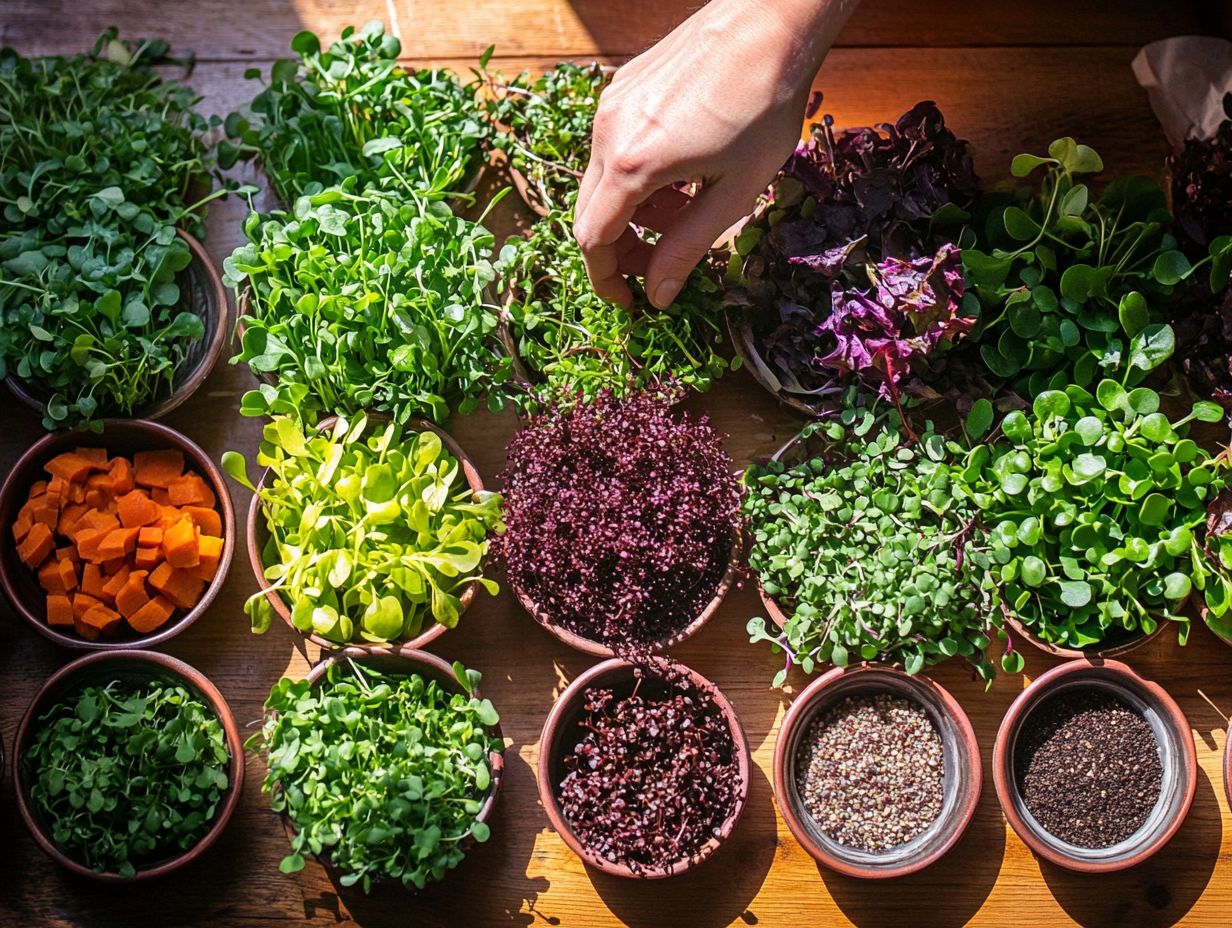
Exploring the diverse varieties of microgreens unveils a captivating array of flavors and textures that can truly elevate your culinary creations. From the bold, peppery notes of arugula to the rich, earthy undertones of beet greens, each variety offers a distinct flavor profile.
This versatility makes them ideal for enhancing both gourmet dishes and your everyday meals, allowing you to infuse a touch of excitement into every bite.
Ready to dive into the world of microgreens? Start by trying to grow your own, and enhance your cooking in delightful ways!
Taste Profiles and Uses
The taste profiles of microgreens are a delightful exploration. They range from sweet varieties like sunflower to the spicy notes of mustard greens. These vibrant flavors can transform your salads, smoothies, and savory dishes, adding both taste and nutrition.
Take, for instance, the peppery punch of arugula microgreens. They offer a zesty contrast to creamy dressings that is simply irresistible. Meanwhile, the earthy undertones of beet greens can bring remarkable depth to a roasted vegetable medley.
When you’re in the kitchen, consider lightly saut ing microgreens like pea shoots to bring out their natural sweetness. You can also toss them into a fresh salsa for a lively twist.
Here are a couple of creative recipe ideas to spark your imagination:
- A microgreen pesto that takes the place of traditional basil.
- Using radish microgreens as a garnish on tacos for an unexpected burst of flavor.
Ultimately, these tiny greens do more than just enhance the aesthetics of your dishes. They invite you on a culinary adventure, showcasing their unique and varied taste profiles.
How to Grow Your Own Microgreens
Growing your own microgreens at home is a delightful gardening adventure. Not only do you yield fresh ingredients, but you also spark your culinary creativity.
With straightforward techniques and minimal space needed, you can effortlessly cultivate these nutritious greens right in your kitchen or garden. This ensures you have a steady supply of vibrant flavors and health benefits at your fingertips.
Step-by-Step Guide to Growing Microgreens at Home
To grow microgreens at home, begin by selecting the right seeds. Next, prepare your growing medium the material you use to grow the plants, such as soil or other plant-friendly materials. Ensure you provide the proper light and water for optimal growth. This step-by-step guide will help you enjoy the abundant benefits of fresh, homegrown microgreens, which can effortlessly enhance a variety of culinary creations.
Choosing seeds that align with your flavor preferences is essential. Whether you’re drawn to the zest of spicy radishes, the subtlety of delicate basil, or the rich earthiness of beets, it’s important to decide on your favorites first. After that, it’s time to prepare your growing medium. Consider options like organic soil, coconut coir, or special mats designed for microgreens. Additionally, exploring the benefits of growing diverse microgreen varieties can enhance your gardening experience.
Maintaining adequate moisture levels is crucial. Be careful not to overwater, as that can lead to unwelcome issues like mold. Light is another vital element; placing your trays near a window or utilizing grow lights can significantly boost their growth.
After nurturing your microgreens for about 7 to 21 days, depending on the variety, you’ll be ready to harvest. Feel free to experiment with different vegetables, as their vibrant flavors can elevate your salads, sandwiches, and smoothies. To help you select the best options, check out this guide on how to choose microgreen varieties for your garden. Incorporating these mini greens into your meals not only enhances nutrition but also adds exciting visual appeal. Don’t miss out on the culinary adventure that microgreens can offer!
Incorporating Microgreens into Your Meals
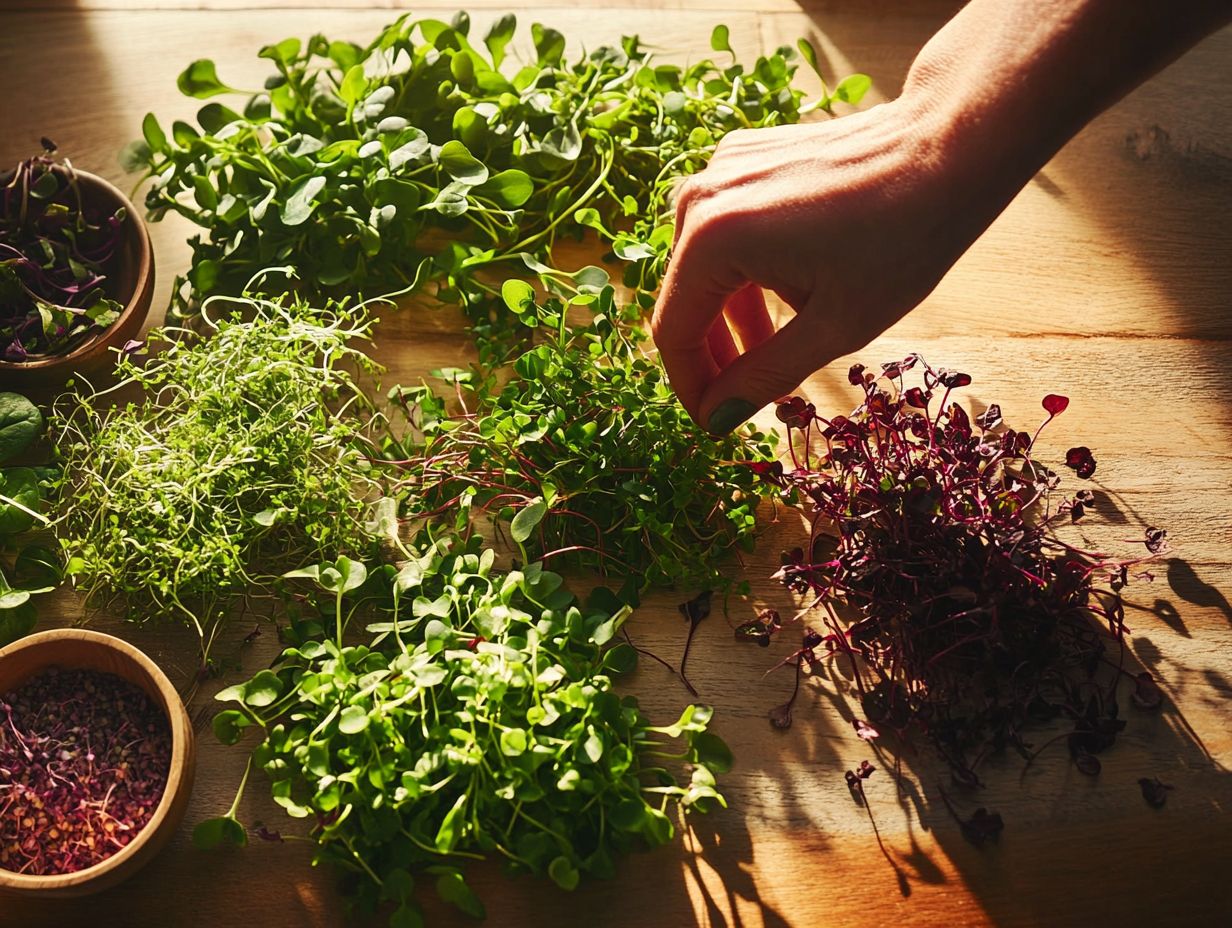
Incorporating microgreens into your meals can truly elevate both the flavor and nutritional profile of your dishes. This showcases your culinary creativity.
These fantastic ingredients can elevate your meals in exciting ways! They lend themselves beautifully to a variety of food pairings, enhancing everything from simple salads to gourmet entrées. If you’re looking to diversify your diet, microgreens are an essential addition that can transform your culinary experience. For a deeper understanding of their unique tastes, check out the microgreen varieties: taste and flavor guide.
Creative Ways to Use Microgreens in Cooking
From elevating savory dishes to adding a delightful crunch to your salads, there are countless creative ways for you to incorporate microgreens into your culinary repertoire. Their vibrant colors and unique flavors are perfect for enhancing both the aesthetics and taste of your meals.
Imagine tossing a handful of these delicate greens into a fresh fruit salad for an unexpected twist, or blending them into a smoothie to give it a nutritious boost. They also shine beautifully as a flavorful addition to gourmet dishes, offering an elegant finishing touch to seafood or poultry.
By experimenting with different varieties, you can uncover exciting flavor combinations that truly elevate your culinary creations. Dive into the world of microgreens! Lightly wilting them into pasta or using them to brighten up a rich soup can let their distinct tastes take center stage. Discover more about ways to enhance flavor in microgreens for even more delicious ideas.
Mixing and Matching Microgreens for Unique Tastes
Mixing and matching different varieties of microgreens allows you to explore unique tastes and flavor combinations that elevate any dish. By understanding the distinctions between sweet, spicy, and earthy microgreens, you can craft exciting blends that enhance your overall dining experience.
For instance, imagine pairing sweet pea shoots with the peppery notes of arugula; this delightful contrast can elevate a fresh salad or sandwich to new heights. Earthy varieties, like beetroots or radishes, provide depth and richness, making them ideal companions for citrus dressings or grilled proteins. To explore more options, check out this guide for beginners on microgreen varieties.
Experimenting with these combinations not only boosts the visual appeal of your dishes but also enriches the flavor profile, inviting you to savor a broad spectrum of sensations. Thoughtfully curated microgreen blends can transform an ordinary meal into a vibrant culinary masterpiece.
Frequently Asked Questions
What are microgreens?
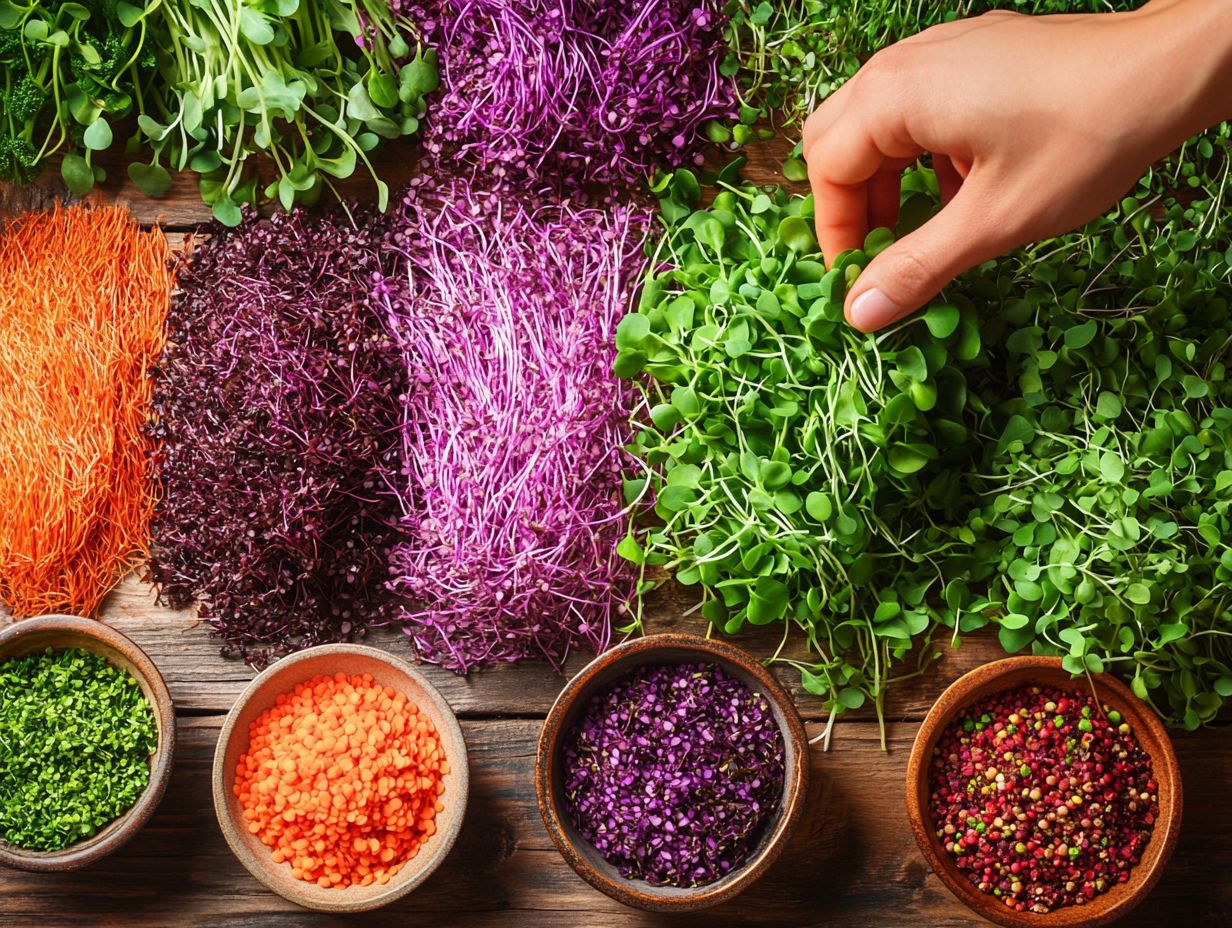
Microgreens are young vegetable or herb plants that are harvested when they are only a few inches tall. They are typically grown in soil or a hydroponic system, which is a method of growing plants without soil, using nutrient-rich water instead, and are harvested within 10-14 days of germination.
Why are microgreens popular?
Microgreens have gained popularity in recent years due to their high nutrient content and intense flavor profiles. They are also easy to grow at home, making them a convenient addition to any diet.
How do different microgreen varieties differ in flavor?
Each variety of microgreen has a unique flavor profile, which can range from sweet and mild to spicy and intense. This is due to the specific plant species and the stage at which it is harvested.
What are some common microgreen varieties and their flavor profiles?
Some common microgreen varieties include:
- Arugula: Peppery and nutty flavor.
- Broccoli: Mild and slightly bitter taste.
- Radish: Known for its spicy kick.
- Sunflower: Slightly sweet and nutty flavor.
How can I incorporate microgreens into my meals?
Microgreens can be used in various dishes, including salads, sandwiches, and smoothies. They can also be added as a garnish to soups, omelets, and other cooked dishes to add flavor and visual appeal.
Are there any tips for enhancing the flavor of microgreens?
To enhance the flavor of your microgreens, try pairing them with complementary ingredients. For example, add peppery arugula microgreens to a sandwich with turkey and mustard, or top a pizza with spicy radish microgreens. You can also experiment with different dressings or sauces to find the perfect flavor combination.
Why not take your cooking to new heights today? Start experimenting with microgreens!

